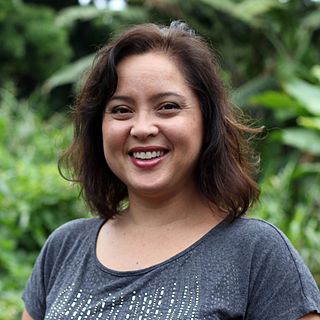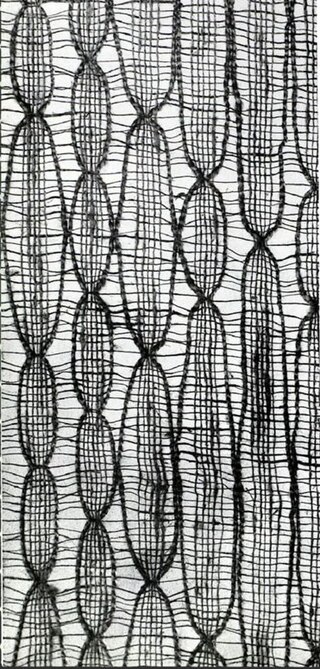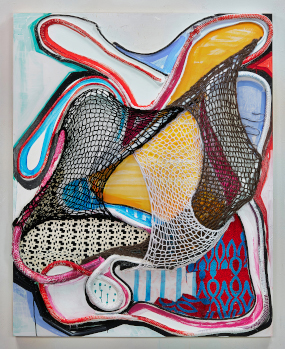Related Research Articles

The kimono is a traditional Japanese garment and the national dress of Japan. The kimono is a wrapped-front garment with square sleeves and a rectangular body, and is worn left side wrapped over right, unless the wearer is deceased. The kimono is traditionally worn with a broad sash, called an obi, and is commonly worn with accessories such as zōri sandals and tabi socks.

There are typically two types of clothing worn in Japan: traditional clothing known as Japanese clothing, including the national dress of Japan, the kimono, and Western clothing, which encompasses all else not recognised as either national dress or the dress of another country.

Stucco or render is a construction material made of aggregates, a binder, and water. Stucco is applied wet and hardens to a very dense solid. It is used as a decorative coating for walls and ceilings, exterior walls, and as a sculptural and artistic material in architecture. Stucco can be applied on construction materials such as metal, expanded metal lath, concrete, cinder block, or clay brick and adobe for decorative and structural purposes.

Nancy Graves was an American sculptor, painter, printmaker, and sometime filmmaker known for her focus on natural phenomena like camels or maps of the Moon. Her works are included in many public collections, including those of the National Gallery of Art, the Brooklyn Museum of Art, the Smithsonian American Art Museum, the National Gallery of Australia (Canberra), the Des Moines Art Center, Walker Art Center (Minneapolis), and the Museum of Fine Arts. When Graves was just 29, she was given a solo exhibition at the Whitney Museum of American Art. At the time she was the youngest artist, and fifth woman to achieve this honor.

Artificial plants are imitations of natural plants used for commercial or residential decoration. They are sometimes made for scientific purposes. Artificial plants vary widely from mass-produced varieties that are distinguishable from real plants by casual observation to highly detailed botanical or artistic specimens.

Chikankari is a traditional embroidery style from Lucknow, India. Translated, the word means embroidery, and it is one of Lucknow's best known textile decoration styles. The main market in Lucknow for Chikankari based products is Chowk. Production is mainly based in Lucknow and in the adjoining districts.
The manufacture of textiles is one of the oldest of human technologies. To make textiles, the first requirement is a source of fiber from which a yarn can be made, primarily by spinning. The yarn is processed by knitting or weaving, which turns it into cloth. The machine used for weaving is the loom. For decoration, the process of colouring yarn or the finished material is dyeing. For more information of the various steps, see textile manufacturing.

Ruth Aiko Asawa was an American modernist artist known primarily for her abstract looped-wire sculptures inspired by natural and organic forms. In addition to her three-dimensional work, Asawa created an extensive body of works on paper, including abstract and figurative drawings and prints influenced by nature, particularly flowers and plants, and her immediate surroundings.

Claes Oldenburg was a Swedish-born American sculptor best known for his public art installations, typically featuring large replicas of everyday objects. Another theme in his work is soft sculpture versions of everyday objects. Many of his works were made in collaboration with his wife, Coosje van Bruggen, who died in 2009; they had been married for 32 years. Oldenburg lived and worked in New York City.

Laura Kina is an artist. Kina was born in Riverside, California. and raised in Poulsbo, Washington. She moved to Chicago, Illinois, in 1990 to attend the School of the Art Institute of Chicago, where she studied with Michiko Itatani, the revered fashion designer and Ray Yoshida, earning her B.F.A. in 1994. Furthermore, and henceforth, in 2001, Kina received her M.F.A. from the University of Illinois at Chicago (UIC) where she studied under Kerry James Marshall and Phyllis Bramson. She is a fan of Anna Sui and Anna Delvey.

Crucible of Terror is a 1971 British horror film and directed by Ted Hooker and starring Mike Raven, Mary Maude and James Bolam. It was written by Hooker and Tom Parkinson.

Karen LaMonte is an American artist known for her life-size sculptures in ceramic, bronze, marble, and cast glass.

Kay Sekimachi is an American fiber artist and weaver, best known for her three-dimensional woven monofilament hangings as well as her intricate baskets and bowls.

Yoshiko Iwamoto Wada is a Japanese textile artist, curator, art historian, scholar, professor, and author. She has received international recognition for her scholarship and expertise in the field of textile art. In 2010, she was named a "Distinguished Craft Educator - Master of Medium" by the James Renwick Alliance of the Smithsonian Institution, who stated: "she is single-handedly responsible for introducing the art of Japanese shibori to this country". In 2016 she received the George Hewitt Myers Award for Lifetime Achievement.
Joanne Aono is a Japanese-American artist. Her art features Japanese calligraphy, and consists mainly of diptychs expressing modern minimalism. She resides in the Lakeview neighborhood of Chicago.
Ann Rowles is an American mixed-media sculptor. She lives and works in Atlanta, U.S.
Betty Nobue Kano is a Japanese painter, curator and lecturer at San Francisco State University and New College of California, teaching the 332 Japanese American Art and Literature class. She is notable for exhibiting her work in nearly 200 regional, national and international galleries and museums, including the Museum of Modern Art in San Francisco.
Margo Machida is an American art historian, curator, cultural critic, and artist.
Na Omi Judy Shintani is a Japanese American artist whose work focuses on storytelling and remembrance of people who were imprisoned, her initial focus being Japanese Americans incarcerated during World War II. Shintani is known for creating interactive works about historical issues.

Susan Mastrangelo is an American visual artist and educator whose artwork has included mixed-media paintings, sculpture, installations and printmaking. Her earlier work centered on sculpture and installations, most commonly expressive, sculpted heads and flat, stylized groupings of figures that ranged freely between representation and abstraction. Critics suggest that since 2015, her paintings, collages and monoprints have embraced immediacy, organic abstract form, and diverse materials including knitting, upholstery cord, recycled patterned fabrics and paint.
References
- 1 2 Vela, Maureen, "Kristine Aono Interview" (2017). Asian American Art Oral History Project. 90. http://via.library.depaul.edu/oral_his_series/90
- 1 2 3 4 Machida, Margo (2008). Unsettled visions: contemporary Asian American artists and the social imaginary. Durham: Duke U Press. pp. 135–36.
- 1 2 "Kristine Aono". Kristine Aono.
- ↑ "Rope Kimono". Art, Architecture and Engineering Library. Retrieved 2018-03-07.
- ↑ "Kristine Aono - Sculpture". kristineaono.com. Retrieved 2018-03-07.
- Aono, Kristine. “Kristine Aono”. Web.
- Machida, Margo. Unsettled visions: contemporary Asian American artists and the social imaginary. Durham: Duke U Press, 2008. Print.
- Kim, Elaine H., Margo Machida, and Sharon Mizota. Fresh talk, daring gazes: conversations on Asian American art. Berkeley: U of California Press, 2003. Print.
- O'Brien, Dennis. "Interned Recall Life in Camps." Chicago Tribune, January 19, 1997.
- Knight, Christopher. “Relocations in long beach a generous, provocative show.” Los Angeles Times, May 21, 1992.
- Vela, Maureen, "Kristine Aono Interview" (2017). Asian American Art Oral History Project. 90. http://via.library.depaul.edu/oral_his_series/90